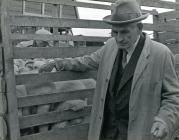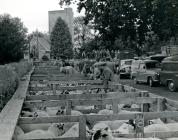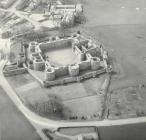Gellir lawrlwytho cynnwys at ddefnydd anfasnachol, megis defnydd personol neu ar gyfer adnoddau addysgol.
Ar gyfer defnydd masnachol cysyllwch yn uniongyrchol gyda deilydd yr hawlfraint os gwelwch yn dda.
Read more about the The Creative Archive Licence.
Disgrifiad
Railways at Gwaun-cae-gurwen
This article is by C L Mowat, it appeared in the Railway Magazine dated December 1957.
Of course, the date is critical to what is described.
Contributed by David Smith (April 2004)
Railways at Gwaun-Cae-Gurwen
A newcolliery is now being sunk by the National Coal Board at Abernant, some ten miles north of Swansea. It is expected to become productive in 1960, and the anthracite obtained from it may infuse new life into the railways of this district, whose chequered history includes an abortive scheme for a direct route to the port of Swansea.
The anthracite coalfield in the Amman Valley was first connected with the railway system when the Llanelly Railway opened its line from Pontardulais to Cwmamman (now Garnant) on April 10, 1840. This was extended 1mile 75 ch. to Gwaun-Cae-Gurwen (or G.C.G., as it is usually called) on May 6, 1841 ; in June, 1842, Garnant became a junction when the line was opened from there to Brynamman. The Llanelly Railway was taken over by the Great Western Railway on January 1, 1873. In 1864, Brynamman was reachedby the Swansea Vale Railway, which was absorbed by the Midland Railway in 1874.
The Llanelly Railway's Gwaun-Cae-Gurwen branch followed the River Garnant up a narrow valley, and finally climbed an incline, six chains long, on a gradient of 1 in 4.9, to reach that village. Two collieries were served on the way, one by an incline ascending the south side of the valley.
In its Act of 1904 (mainly concerned with the authorisation of the Swansea District Lines from Court Sart and Skewen to Morlais Junction), the Great Western received powers to build a new single-track Gwaun-Cae-Gurwen branch, which was opened on November 4, 1907. This starts just east of Raven Crossing, at the east end of the branch platform at Garnant, and rises at a gradient of 1in 40 throughout its length of 1 mile 22 ch. The new line begins on the north side of the old branch, but crosses over itafter about half a mile and climbs in cutting along the south-west side of the valley, which it finally crosses on a brick viaduct of five arches, 66 yd. long, with a maximum height of 30 ft. Immediately beyond this, it joins the course of the old line, just west of the level crossing at Gwaun-Cae-Gurwen.
On the opening of the new line, 59 ch. of the old, at the eastern end and including the incline, were closed. The remainder continued under the name of the Cawdor branch to serve the two collieries. The sidings at the foot of the incline were removed in 1933, and the rails were lifted from the rest of the branch 17 years later, in 1950.
At Gwaun-Cae-Gurwen there is a signal-box controlling the level crossing and the entrance to a group of sidings. From there lines continue to the east and south to serve three collieries, and make connection with a colliery line which joins the former Midland branch just west of Cwmllynfell Station, at a signal box which is also called Gwaun-CaeGurwen.
On January 1, 1908, the G.W.R, inaugurated a passenger service from Garnant to Gwaun-Cae-Gurwen by a steam railcar. Halts were opened at Gors-y-Garnant, Red Lion Crossing, and the terminus ; the latter was just west of the level crossing. Eight trips a day were worked at first, and the service continued with little change throughout its history. It was discontinued in June, 1926. Atpresent there are six workings of mineral trains daily over the branch, several them through to Pantyffynnon. The branchis worked by electric train staff and speed over it is restricted to 10m.p.h.
In 1911 the Great Western sought powers to construct a railway, about ten miles long, from Gwaun-Cae-Gurwen southwards to Felin Fran on the Swansea District line, then under construction (it was opened in two stages, on February 18, 1912, and July 14, 1913). Its object as stated in the parliamentary hearings was to shorten the route from Brynamman to Swansea and to develop the anthracite coalfield between Brynamman and Cwmgorse and between Pontardawe and Clydach. The estimated cost was ©310,000. The main linewas to begin with triangular junctions at Gwaun-Cae-Gurwen ; in addition, an eastern curve was to be constructed near Garnant from the Gwaun-Cae-Gurwen branch to the Brynamman line.
From Gwaun-Cae-Gurwen the line ran on easy gradients to the head of the valley of the Upper Clydach River, and from there descended at 1 in 50 to Rhyd-y-fro. Here a branch, 2 miles 31 ch. long, was to run in a north-easterly direction, up the valley of the Egel at gradients of 1 in 47 and 1 in 41 to a terminus near Blaen-egel-fawr. The main line continued southwards, crossing the Upper Clydach three times within the first mile from Rhyd-y-fro. The third crossing was by a viaduct 100 yd. long and 110 ft. high.This and the second bridge would, however, have been eliminated by a diversion carrying the line on the western side of the valley in cutting, under powers sought in 1912.
Beyond the viaduct, the line entered a tunnel 103 yd. long, and then curved sharply south-west, above All Saints Church, Pontardawe, and descended at 1 in 90 along the side of the ridge above Pontardawe and the Swansea Valley. At the bottom of this descent the town of Clydach was crossed on embankment, followed by bridges over the Swansea Canal, the Midland Railway and the River Tawe, the latter one of seven spans. Another mile over level country brought the line to triangular junctions at FelinFran,where it ended. A branch from Clydach, north-westwards to join a colliery tramway, was also proposed, but was defeated, partly because it would pass very close to the parish church. A similar line was authorised in the Great Western Act of 1912, which also provided for a branch 5 7/8 miles long from Clydach to Mynydd Bettws Common.
In the parliamentary hearings, counsel for the Great Western referred to an earlier scheme for the same route - that of the Neath, Pontardawe & Brynamman Railway. A company of this name obtained an Act of Parliament in 1895 to build a line 12 miles long from junctions with the South Wales main line and the Vale of Neath line of the Great Western at Neath to junctions with the Midland and the Great Western lines at Brynamman. Fairly steep gradients would have been needed to carry the line over the countrybetween Neath and Pontardawe (where two curves to the Midland Railway were to be constructed). At Pontardawe the line was to cross the Swansea Valley on a viaduct 500 yd. long and 90 ft. high ; this was to be followed by a tunnel of 500 yd. and a viaduct 170 yd. long and 89 ft. high over the Upper Clydach. There was to be a branch from Rhyd-y-fro to Blaen-egel,Gwaun-Cae-Gurwen.
Powers under the Act lapsed, but were revived, in spite of the Great Western's opposition, in 1903, when additional connections with the Rhondda & Swansea Bay Railway at Neath were authorised. A branch from near Gwaun-Cae-Gurwen to join the G.W.R. at Garnant (parallel with the route of the Great Western's branch of 1904) also was proposed. In 1907 the company obtained an extension of time, having gained promise of a subscription of capital from the Barry Railway. The company powers lapsed in 1912.
The Great Western obtained powers for its line from Gwaun-Cae-Gurwen to Felin Fran in its Act of August 18, 1911, but only succeeded in carrying out part ofthe scheme because of the interruption of the first world war. The northern section of the main line, from Gwaun-Cae-Gurwen to Duke Colliery, 2 miles 36 ch.was opened to goods traffic on August 3, 1923. The east curve at Gwaun-Cae-Gurwen, 28 ch. long, was built but not brought into use. This must have been a most expensive white elephant, forit includes a brick viaduct of four arches adjacent to the viaduct on the branch.
The southern part of the projected line was opened from Felin Fran East Signal Box to Mond's Nickel Works,Clydach, on December 11, 1922, and extended on August 3, 1923, to Trebanos (for Daren Colliery), about a mile south of the proposed tunnel above Pontardawe.
The track formation was constructed for another mile or more northward, including the heading of the tunnel in rock. Neither the west curve at Felin Fran, the east curve at Garnant, nor the branches were built, and a passenger service over the line was never instituted. A Railway Clearing House map of 1926 shows projected stations at Clydach, Pontardawe and Rhyd-y-fro. At present one freight working from Felin Fran to Trebanos is scheduled on five days a week, with additional trips to Felin Fran Colliery andMond's Works. The line is worked by one engine in steam, with wooden train staff.
The northern part of the line has today a derelict air about it. Though constructed for double track, it is only single. It begins at a ground frame on the Gwaun-cae-Gurwen branch, curves south in cutting before joining the course of the east curve to that village, and then passes through the first of two ghost stations, which were never opened to traffic. This was designed to serveGwaun Cae-Gurwen though badly placed for the village. It has two long platforms edged with masonry, and neatbrick buildings on each; those on the south bound platform are used as a private house.
There is a similar station at Cwmgorse, though the platforms are mere ramparts of turf ; here also the main building has become a private house. A siding serves a small factory immediately to the south. The line continues along a shallow valley over bare, somewhat boggy ground. At about 1 1/4miles from Cwmgorse it crosses a side-road, from Nant-y-gaseg to Pwllau Watkin, on the level ; gates are provided. It terminates about a quarter of a mile beyond this ;there is a run-round loop, and sidings to the new Abernant Colliery which lies close by near the site of Duke Colliery. At present no service is scheduled over the line, but it has recently been relaid and may expect a busy traffic when Abernant Colliery is opened in 1960.
But will the missing link to Pontardawe and Trebanos ever be built?
There are photographs of local railway features throughout the Picture Gallery, and under Railways scenes in particular.
See profile page for copyright and acknowledgements.






Oes gennych chi wybodaeth ychwanegol am yr eitem hon? Gadewch sylwad isod
Sylwadau (0)
Rhaid mewngofnodi i bostio sylw